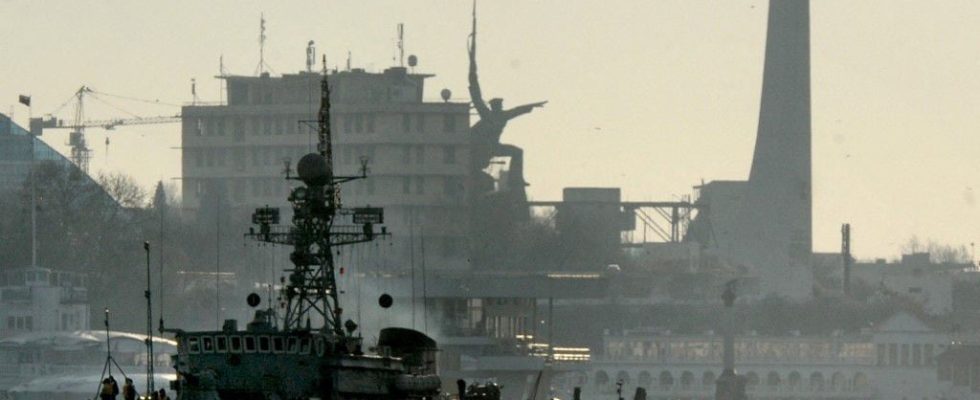On the night of March 4 to 5, near the Kerch Strait in the Black Sea, several Ukrainian surface drones discreetly sailed towards the Russian patrol boat. Sergei Kotov. After reaching its hull, one of the devices detonated in an immense spray of flames. Severely damaged by several impacts, the ship – 1,300 tonnes and 94 meters long – will end up, according to kyiv, sinking five kilometers from the coast of Crimea. The video of this operation, released by Ukrainian military intelligence, is only the latest in a long series of actions of the same type launched by kyiv in recent months.
Less than three weeks before, on February 14, Ukrainian forces had sent the Caesar Kunikov, a landing ship, off the coast of Crimea. “Ukraine has proven what it is capable of,” Volodymyr Zelensky boasted on March 6. “There is no refuge for Russian terrorists in the Black Sea and there never will be.” In either case, the attack was carried out by the Ukrainian special forces unit “Group 13”, using Magura V5 drones, unmanned vehicles moving on the water surface .
“A very good deal”
“These are fairly basic boats controlled remotely by an operator connected to an onboard camera,” explains Léo Péria-Peigné, arms and foresight researcher at the French Institute of International Relations. Thanks to their hydro-jet, they are capable of move relatively quickly along the waves to strike the enemy.” 5.5 meters long, the Magura V5 can travel up to 800 kilometers and has a battery life of sixty hours.
With its 200 kg of explosives, it leaves enemy ships little chance. “A drone that hits the target with such a military load can be enough to put a ship out of action,” adds former admiral Pascal Ausseur, now director general of the Mediterranean Foundation for Strategic Studies. If the opposing boat is very loaded with ammunition – as is often the case with Russian ships – this also has a high chance of causing secondary explosions and fires on board.”
Beyond its destructive capabilities, its price – $250,000 per unit for a Magura V5 drone – remains relatively affordable for the Ukrainian forces. “It’s a very good deal for destroying warships worth several tens, or even hundreds, of millions of dollars,” confirms the admiral. According to kyiv, the Sergei Kotov – one of the newest ships in the Russian fleet, commissioned in 2022 – was worth around $65 million.
Used from October 2022 to attack the port of Sevastopol, Ukrainian surface drones have since continued to increase their hunting range. In July 2023, Moscow accused Ukraine of having used it to strike the very strategic Kerch bridge, linking Russia to the Crimean peninsula, a crucial logistical axis for supplying the Russian army.
New generation drones
Over time, the Ukrainians were able to perfect their modus operandi. “The largest and slowest ships are attacked directly on the flanks, trying to strike several times in the same place to create a significant leak,” points out Léo Péria-Peigné. For faster ships, such as corvettes , this is accompanied by a first strike against the engines in order to immobilize them.” The fight against these attacks is all the more difficult as they generally take place at night and the small size of drones complicates their detection by radar.
After two years of war, the Russian navy has already paid a heavy price. In early February, the Ukrainian General Staff claimed the destruction of more than a third of its fleet based in the Black Sea thanks to the combined use of its surface drones and long-range missiles. Far from being anecdotal, these raids allowed Kiev to maintain its maritime grain corridor – vital for the country’s economy – by pushing the Russian fleet to withdraw towards the eastern coasts of the Black Sea. Satellite images taken between June and December 2023 showed that Moscow had been forced to move part of its resources from its historic base of Sevastopol, in Crimea, to the port of Novorossisk, in the Krasnodar region.
“While they almost no longer have a navy, the Ukrainians have succeeded in making the Black Sea an extremely dangerous space for Russian forces,” summarizes Admiral Ausseur. “Thanks to their surface drones, they are capable of carrying the fight several hundred kilometers from the coast.” Or even more soon? On March 6, kyiv presented a new generation of surface drones called Sea Baby – the first batch of which was nicknamed Avdiivka in homage to the Ukrainian city lost in February – capable, according to the army, of carrying up to a ton of explosives 1000 kilometers away. For the Russian navy, the nightmare will continue.
.
